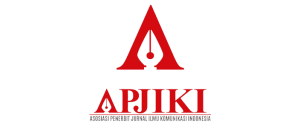Strategi Public Relations Untuk Menciptakan Minat Pengunjung Ke Galeri Indonesia Kaya
DOI:
https://doi.org/10.30656/lontar.v7i1.1563Keywords:
Public Relations, Strategy, Gallery, VisitorsAbstract
One of the most important tools in gallery is Public Relations. The existence of Public Relations in aGallery can be a bridge between the gallery with its public. The purpose of Public Relations in a
Gallery is to disseminate information, create, and maintain good harmonious relationships in order
to get a positive image of the Gallery. However, the abundance of Galleries in Jakarta, causes a
lack of public interest in visiting Gallery Indonesia Kaya. This causes the need for a Public
Relations strategy that is used to increase visitors’. This research was conducted by using
qualitative method through interview and observation. From the results of interviews and
observation, researchers found that the Gallery Indonesia Kaya performs strategies of Public
Relations to increase visitor’s interest. Researchers also found that Gallery Indonesia Kaya has not
succeeded in doing strategy of Public Relations to increase visitors’ interest because the
inconsistency between strategy and hope which executed with expectation to be achieved.
References
Anggraeni, N., Siswoyo , M., dan Nurfalah,
F. (2014, Juli). Stategi Public
Relations dalam Mendukung
Pemasaran Pembangkit Listrik
Nasional. 2(3). Dikutip dari
http://www.tappdf.com/read/866070-
strategi-public-relations-dalammendukung-jurnal-aspikom.
Ardianto, E. (2016, September). Metode
Penelitian untuk Public Relations
Kuantitatif dan Kualitatif. Bandung:
Remaja Rosdakarya.
Crawford, T and Mellon, S. (2010). The Ertist
Gallery Partnership: A Practical
Guide to Consigning Art. New York:
Skyhorse Publisihing.Inc.
Fasilitas. (2017). Galeri Indonesia Kaya.
Diperoleh dari website:
https://www.indonesiakaya.com/galer
i-indonesia-kaya/fasilitas
Gaffar, V. (2011). Pengaruh Strategi
Positioning Museum Terhadap
Kunjungan Wisata Edukasi di Kota
Bandung (Survey Segmen Pasar
Generasi Y). 1(1), Abstrak dikutip
dari ejournal.upi.edu/index.php
/thejournal/article/download/1878/12
Gassing, S. G. (2016). Public Relations.
Yogyakarta: C.V Offset
Tentang kami. (2017). Galeri Indonesia Kaya.
Diperoleh dari website:
https://www.indonesiakaya.com/galer
i-indonesia-kaya/tentang-kami
Ismayanti. (2010) . Pengantar Pariwisata.
Jakarta: PT. Grasiondo
Jefkins, F. (2015, April). Public Relations.
Jakarta: Erlangga
Kriyantono, Ph. D. (2017). Teori-Teori Public
Relations Perspektif Barat & Lokal:
Aplikasi Penelitian dan Praktik.
Jakarta: Kencana
Moleong, L. J. (2010, Oktober). Metode
penelitian Kualitatif. Bandung:
PT.Remaja Rosdakarya
Morissan. (2010, Agustus). Manajemen
Public Relations. Jakarta: Kencana
Nurjaman, K. dan Umam, K. (2012).
Komunikasi & Public Relation.
Bandung: Pustaka Setia
Prayogo, H, S. (2017). Diakses 29 September
Diperoleh dari webite:
https://www.wartaekonomi.co.id/read
/inilah-peraih-indonesia-prexcellence-award-2017.html
Qorib, F. dan Syahida, A, R. (2017). Strategi
Public Relations Museum Angkut
Kota Batu Untuk Meningkatkan
kunjungan Wisatawan. 7(1), 2088-
diperoleh dari
/index.php/reformasi/article
/viewFile/697/681
Remaja Rosdakarya.
Rofa’ah. (Juni 2016). Pentingnya Kopetensi
Guru dalam Kegiatan Pembelajaran
dalam Perspektif Islam. Yogyakarta:
Grup Penervitan CV Budi Utama.
Ruslan, R. (2014, Febuari). Manajemen
Public Relations media& komunikasi.
Depok: PT Rajagrafindo Persada.
Solihat, A. dan Ary, M. (2016, September).
Analisa Minat Wisata Museum Kota
Bandung. 3(2), 2355-6587 Diperoleh
dari
http://ejournal.bsi.ac.id/ejurnal/index.
php/jp/article/view/1517
Shihab, M dan Musiasa, I, N. (2017). Strategi
Public Relations dan Pencak Silat
Tradisional. 6(1), 2442-6962.
diperoleh dari
https://publikasi.unitri.ac.id/
index.php /fisip/article/view/ 363/296
Slameto. (2015, Desember). Belajar dan
Faktor-Faktor yg Mempengaruhi.
Jakarta PT. Rineka Cipta
Sugyono. (2010, November). Memahami
Penelitian Kualitatif. Bandung:
Alfabeta.
Sugyono. (2015, Desember). Metode
Penelitian Kuantitaif, Kualitatif, Dan
R&D. Bandung: Alfabeta
Wasesa, S. A. (2010). Strategi Public
Relations. Jakarta: PT Gramedia
Pustaka Utama
Downloads
Published
Issue
Section
License
By submitting an article to the journal, the author(s) agree to transfer the published article's copyright to the journal, which will act as the publisher. This means the journal will have the right to publish the article in various forms, including reprints. The journal will maintain the publishing rights to the published articles.
In line with the license, authors and third parties (readers, researchers, and others) are allowed to share and adapt the material. In addition, the material must be given appropriate credit, provided with a link to the license, and indicated if changes were made. If authors remix, transform, or build upon the material, authors must distribute their contributions under the same license as the original.






